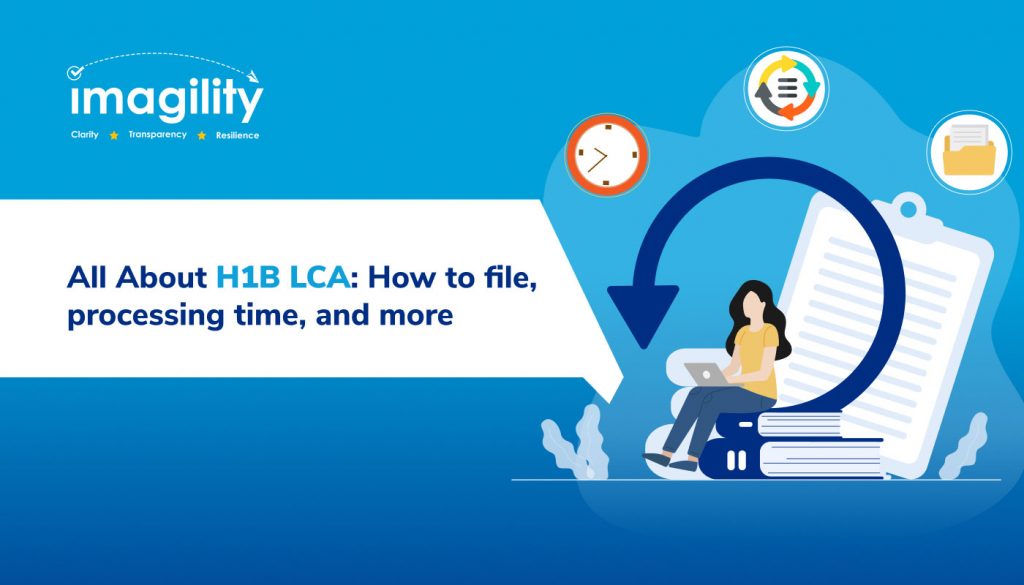Table of Contents
What is the H1B LCA?
How to file an H1B LCA?
What does the H1B LCA form contain?
Attestations made in the LCA
H1B LCA processing time
Public Access File
Concluding thoughts
H1B LCA is a mandatory step to secure the H1B visa. Before the petitioner applies for an H-1B visa, they have to file an LCA at the Department of Labor (DOL) for approval.
Only if the LCA (Labor Condition Application) is approved, employers can file an H1B petition along with a certified LCA to the USCIS., But if rejected, it is of no use to file an H1B petition. USCIS will reject the H1B petition without a certified LCA. Hence it becomes crucial to understand the various factors that lead to an LCA getting approved.
In this blog, we will discuss what H1B LCA is, how to file it, the processing time, and more to help you understand the process of getting an LCA approved.
What is the H1B LCA?
H1B LCA is a form (ETA-9035 and 9035E) that the employer has to file with the US Department of Labor after the candidate is shortlisted in the H1B lottery registration. As LCA stands for Labor Condition Application, the sole purpose of LCA is to see whether the employer is hiring a foreign worker with the same prevailing wage and work conditions as current employees and not affecting the present employee’s work conditions. This is followed as per Immigration and Nationality Act (INA) norms to meet specific wage and work condition requirements for the non-immigrant worker.
How to file an H1B LCA?
To file an H1B LCA, employers must submit the form ETA-9035 with the US Department of Labor. Employers can submit the form six months before the foreign worker is expected to start the position. There are two ways to file the H1B labor condition application:
- The employer can submit the H1B LCA electronically through the Foreign Labor Application Gateway (FLAG) system.
- The employer can submit the LCA application via mail if he has a physical disability or is unable to access the Internet. The only thing that needs to be taken care of is that the employer has to first get pre-approval from DOL to submit H1B LCA via mail.
What does the H1B LCA form contain?
The H1B LCA form has all the essential information that DOL needs from the employer. Let’s take a closer look:
- Job title and period of employment
- Is the job offered full-time or not
- Place of employment
- Is the non-immigrant worker a new or existing one
- Prevailing wage in the same employment area
- Contact information of the employer and attorney
Attestations made in the LCA
The employer needs to make attestations while applying for an H1B LCA with the Department of Labor. The DOL introduced the H1B LCA to ensure non-immigrant workers are treated fairly and conform to employment rights like wages, working conditions, policies, etc. Hence, the DOL ensures employers are not taking advantage of new foreign workers and provides them with appropriate prevailing wages and work conditions. Below is the attestation employers have to make:
- The new foreign worker will be paid as per the actual wage (pay rates which companies employees with the same qualifications are getting) or prevailing wage (pay rates offered in a particular location), whichever is higher. Employers must pay the new foreign worker for the non-productive hours too.
- The new foreign worker will get the same work conditions as the employees of the same geographical area and not adversely impact the working conditions of the other employees. Working conditions refer to work hours, shifts, vacations, etc.
- There is no strike or work stoppage at the place of employment while filing the H1B labor condition application. The purpose of this is to ensure that the employer is not trying to replace the striking workers.
- The employers must inform the workers of the company about their intent to hire and cannot do so secretly.
H1B LCA processing time
As per the US Department of Labor, H1B LCA are reviewed within 7 working days to see if there are any inaccuracies or potential errors.

However, this time may increase depending on some factors:
- If the employer has never applied for the H1B LCA before, the DOL system may not recognize Federal Employer Identification Number (FEIN). So the employer must first verify FEIN with the Department of Labor, which may take 5 working days.
- The workload and the number of applications at DOL.
Public Access File
The DOL needs employers to make the certified H1B LCA and other supported documents available for the public examination for each H1B worker. Employers need to create and maintain a document for Public Access File (PAF) in compliance with each H1B case. Employers must maintain PAF one year beyond the date mentioned on the LCA and one year after the LCA is withdrawn. Let’s look at the variables the PAF must include:
- A copy of the certified H1B LCA
- A copy of the LCA signed and accepted by the worker
- The letter mentioning the wage of the H1B worker
- Explanation of how the system determines to pay actual wage
- Document related to prevailing wage and actual wage
- If the employer is H1B dependent or has been found to violate the LCA regulations, evidence of the attempt to recruit US workers.
Concluding thoughts
Employers can check the status of LCA by logging into the Foreign Labor Application Gateway (FLAG) system anytime. Once H1B LCA is approved, employers can proceed with the H1B petition to the USCIS for H1B visa approval. Initially, the H1B LCA is given for three years, just like H1B. Employers can not renew the LCA and must apply for a new LCA while filing a new I-129 (for transfers and renewals).










